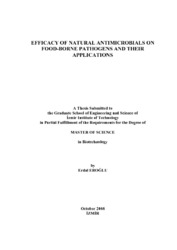Please use this identifier to cite or link to this item:
https://hdl.handle.net/11147/3629Full metadata record
| DC Field | Value | Language |
|---|---|---|
| dc.contributor.advisor | Soyer Dönmez, Ferda | - |
| dc.contributor.author | Eroğlu, Erdal | - |
| dc.date.accessioned | 2014-07-22T13:51:59Z | - |
| dc.date.available | 2014-07-22T13:51:59Z | - |
| dc.date.issued | 2008 | - |
| dc.identifier.uri | http://hdl.handle.net/11147/3629 | - |
| dc.description | Thesis (Master)--Izmir Institute of Technology, Biotechnology, Izmir, 2008 | en_US |
| dc.description | Includes bibliographical references (leaves: 60-71) | en_US |
| dc.description | Text in English; Abstract: Turkish and English | en_US |
| dc.description | xiv, 85 leaves | en_US |
| dc.description.abstract | Microbial contamination of food products increases the risk of food-borne infections and intoxications. In recent years, more studies have been performed for development of natural alternatives to control the growth of pathogenic microorganisms in food rather than chemical origin. In the present study, natural antimicrobial agents from different sources, activated lactoferrin-(ALF), rosemary extract-(RE), jenseniin-G (JG) and natamycin-(NA) were used.The antimicrobial activity of agents (ALF-RE-JG) and their combinations against L. monocytogenes, E. coli O157:H7 and S. Enteritidis, and NA against A. niger and P. roquefortii was tested. These antimicrobials, found effective in vitro, applied also on meat and cheese samples. The minimum inhibitory concentrations (MIC) of ALF, RE and JG against pathogens were determined via disc diffusion and microtiter plate growth assay. Dipping method was applied on meat samples to test the efficacy of antimicrobials. MIC of NA was determined via disc diffusion assay. NA was applied on cheese samples to test the efficacy against both molds by dipping method.The data from microtiter well plate assay showed that ALF is effective on three pathogens. Rosemary extract inhibited only growth of L. monocytogenes and JG did not show any significant activity on the growth of same pathogens. RE enhanced the activity of ALF on E. coli O157:H7. Neither individual activity nor synergistic activity was determined by disc diffusion assay. The data from disc diffusion assay revealed that the effective NA concentration on both molds was 750 ppm. Some of dipping applications on both meat and cheese displayed promising results. | en_US |
| dc.language.iso | en | en_US |
| dc.publisher | Izmir Institute of Technology | en_US |
| dc.rights | info:eu-repo/semantics/openAccess | en_US |
| dc.subject.lcc | QR201.F62 E718 2008 | en |
| dc.subject.lcsh | Foodborne diseases | en |
| dc.subject.lcsh | Food Microbiology | en |
| dc.subject.lcsh | Anti-infective agents | en |
| dc.subject.lcsh | Food additives | en |
| dc.title | Efficacy of Natural Antimicrobials on Food-Borne Pathogens and Their Applications | en_US |
| dc.type | Master Thesis | en_US |
| dc.institutionauthor | Eroğlu, Erdal | - |
| dc.department | Thesis (Master)--İzmir Institute of Technology, Bioengineering | en_US |
| dc.relation.publicationcategory | Tez | en_US |
| dc.identifier.wosquality | N/A | - |
| dc.identifier.scopusquality | N/A | - |
| item.grantfulltext | open | - |
| item.languageiso639-1 | en | - |
| item.openairetype | Master Thesis | - |
| item.openairecristype | http://purl.org/coar/resource_type/c_18cf | - |
| item.fulltext | With Fulltext | - |
| item.cerifentitytype | Publications | - |
| Appears in Collections: | Master Degree / Yüksek Lisans Tezleri | |
Files in This Item:
| File | Description | Size | Format | |
|---|---|---|---|---|
| T000761.pdf | MasterThesis | 2.63 MB | Adobe PDF |  View/Open |
CORE Recommender
Page view(s)
314
checked on Aug 4, 2025
Download(s)
118
checked on Aug 4, 2025
Google ScholarTM
Check
Items in GCRIS Repository are protected by copyright, with all rights reserved, unless otherwise indicated.